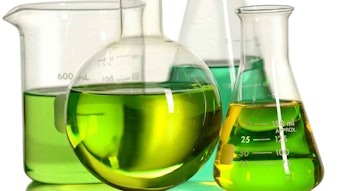Water-soluble polyelectrolytes based on acrylamidopropane sulphonic acid (AMP-S) are an important class of rheology modifiers for personal care products. In this article new hydrophobically modified AMP-S polymers are presented. As hydrophobic co-monomers, methylacrylate esters of ethoxylated fatty alcohols were used for this study. Methacrylate esters were chosen as they provide a convenient way of incorporating the alcohol ethoxylate structure in an AMP-S polymer.
By varying the lengths of the alkyl and polyethylene oxide side chains in the co-monomer, and especially the content of co-monomer, a wide variety of structures can be obtained. This variety enables the rheology to be tailored to give new application profiles. The synthetic methods developed are suitable for production on an industrial scale.
Advantages of the polymers include good electrolyte tolerance, stability over a wide pH range, and compatibility with polar solvents. Incorporation of the hydrophobic chains gives the polymers excellent emulsifying properties, so that they are very suitable for the formulation of surfactant-free emulsions (cream gels).
Water-soluble polymers are tools for regulating the rheology of cosmetic formulations. The rheological profile is a major factor in several important product characteristics, such as skin feel, physical stability and ease of application. Optimizing these characteristics requires sophisticated polymers that can be tailored to give a wide range of special properties.
One method of polymer modification is to attach hydrophobic groups to a hydrophilic backbone1 to give a comblike structure. A variation of this technique is to use amphiphilic side chains consisting of polyethylene oxide and hydrocarbon portions. The side chains can undergo both inter- and intra-molecular aggregation. Polymers with amphiphilic or hydrophobic chains behave in some respects like surfactants; in particular, they form micellelike structures (Figure 1) and have emulsifier properties. A large variation of rheological properties can be obtained by adjusting the content of side chains and the lengths of their hydrophilic and hydrophobic portions.
Cross-linking provides a further method of varying the structure. Crosslinked polymers generally give higher viscosities, but the effects of intermolecular association are less pronounced. For the complete article, click on "Purchase this article."










